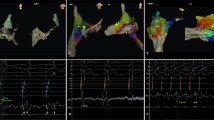Abstract
Electrophysiology study (EPS) and catheter ablation (CA) in children and adolescents carries a potentially harmful effect of radiation exposure when performed with the use of fluoroscopy. Our aim was to evaluate the feasibility, safety and effectiveness of fluoroless EPS and CA of various supra-ventricular tachycardias (SVTs) with the use of the 3D mapping system and intracardiac echocardiography (ICE). Forty-three consecutive children and adolescents (age 13 ± 3 years) underwent fluoroless EPS and CA for various supra-ventricular tachycardias. A three-dimensional (3D) mapping system NavX™ was used for guidance of diagnostic and ablation catheters in the heart. ICE was used as a fundamental imaging tool for transseptal punctures. Acute procedural success rate was 100 %. There were no procedure related complications and short-term follow up (10 ± 3 months) revealed 93 % arrhythmia free survival rate. Fluoroless CA of various SVTs in the paediatric population is feasible, safe and can be performed successfully with 3D mapping system and ICE.





Similar content being viewed by others
References
Heidbuchel H, Wittkampf FHM, Vano E, Ernst S, Schilling R, Picano E, Mont L (2014) Practical ways to reduce radiation dose for patients and staff during device implantations and electrophysiological procedures. Europace 16:946–964
Gellis LA, Ceresnak SR, Gates GJ, Nappo L, Pass RH (2013) Reducing patient radiation dosage during pediatric SVT ablations using an “ALARA” radiation reduction protocol in the modern fluoroscopic era. Pacing Clin Electrophysiol 36:688–694
Fernández-Gómez JM, Moriña-Vázquez P, Morales Edel R, Venegas-Gamero J, Barba-Pichardo R, Carranza MH (2014) Exclusion of fluoroscopy use in catheter ablation procedures: six years of experience at a single center. J Cardiovasc Electrophysiol 25:638–644
Stec S, Sledz J, Mazij M, Ras M, Ludwik B, Chrabaszcz M et al (2014) Feasibility of implementation of a “simplified, no-X-ray, no-lead apron, two-catheter approach” for ablation of supraventricular arrhythmias in children and adults. J Cardiovasc Electrophysiol 25:866–874
Clark J, Bockoven JR, Lane J, Patel CR, Smith G (2008) Use of three-dimensional catheter guidance and trans-esophageal echocardiography to eliminate fluoroscopy in catheter ablation of left-sided accessory pathways. Pacing Clin Electrophysiol 31:283–289
Scaglione M, Ebrille E, Caponi D, Siboldi A, Bertero G, Di Donna P et al (2015) Zero-fluoroscopy ablation of accessory pathways in children and adolescents: CARTO3 electroanatomic mapping combined with RF and cryoenergy. Pacing Clin Electrophysiol 38:675–681
Valentin J (2000) Avoidance of radiation injuries from medical interventional procedures. Ann ICRP 30:7–67
Lai P, McNeil SM, Gordon CL, Connolly BL (2014) Effective doses in children: association with common complex imaging techniques used during interventional radiology procedures. Am J Roentgenol 203:1336–1344
Happonen JM, Hiippala A (2014) Population-based single-center outcome for pediatric catheter ablation of common supraventricular tachycardias. Pacing Clin Electrophysiol 00:1–5
Lee PC, Hwang B, Chen SA, Tai CGT, Chen YJ, Chiang CE, Meng CCL (2007) The results of radiofrequency catheter ablation of supraventricular tachycardia in children. Pacing Clin Electrophysiol 30:655–661
Kopelman HA, Prater SP, Tondato F, Chronos NAF, Peters NS (2003) Slow pathwaycatheter ablation of atrioventricular nodal re-entrant tachycardia guided by electroanatomical mapping: a randomized comparison to the conventional approach. Europace 5:171–174
Álvarez M, Tercedor L, Almansa I, Ros N, Galdeano RS, Burillo F, Santiago P et al (2009) Safety and feasibility of catheter ablation for atrioventricular nodal re-entrant tachycardia without fluoroscopic guidance. Heart Rhythm 6:1714–1720
Casella M, Pelargonio G, Dello Russo A, Riva S, Bartoletti S, Santangeli P, Scarà A et al (2011) “Near-zero” fluoroscopic exposure in supraventricular arrhythmia ablation using the EnSite NavX™ mapping system: personal experience and review of the literature. J Interv Card Electrophysiol 31:109–118
Razminia M, Manankil MF, Eryazici PLS, Arrieta-Garcia C, Wang T, D’Silva OJ, Lopez CS et al (2012) Nonfluoroscopic catheter ablation of cardiac arrhythmias in adults: feasibility, safety, and efficacy. J Cardiovasc Electrophysiol 23:1078–1086
Mah DY, Miyake CY, Sherwin ED, Walsh A, Anderson MJ, Western K, Abrams DJ et al (2014) The use of an integrated electroanatomic mapping system and intracardiac echocardiography to reduce radiation exposure in children and young adults undergoing ablation of supraventricular tachycardia. Europace 16:277–283
Shepherd EJ, Gall SA, Furniss SS (2008) Interatrial septal puncture without the use of fluoroscopy-reducing ionizing radiation in left atrial ablation procedures. J Interv Card Electrophysiol 22:183–187
Funding
Authors received no funding for this study.
Author information
Authors and Affiliations
Corresponding author
Ethics declarations
Conflict of interest
Authors report no conflict of interest.
Ethical approval
All procedures performed in this study were in accordance with the ethical standards of the institutional and the national medical ethics committee and with the 1964 Helsinki declaration and its later amendments.
Informed consent
All patients or their parents gave written informed consent before entering the study.
Rights and permissions
About this article
Cite this article
Jan, M., Žižek, D., Rupar, K. et al. Fluoroless catheter ablation of various right and left sided supra-ventricular tachycardias in children and adolescents. Int J Cardiovasc Imaging 32, 1609–1616 (2016). https://doi.org/10.1007/s10554-016-0952-7
Received:
Accepted:
Published:
Issue Date:
DOI: https://doi.org/10.1007/s10554-016-0952-7




